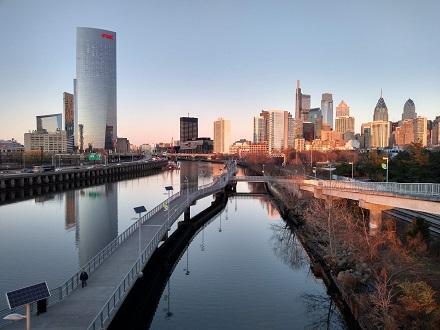

The only question: Why isn’t its 2020 counterpart already active?
The concept, named the Greenway Stimulus, has been put forward by the East Coast Greenway Alliance. It is a straightforward idea: put people to work building a national network of connected walking and cycling infrastructure.
The East Coast Greenway already connects 15 states and 450 cities and towns for 3,000 miles from Maine to Florida, providing an alternative to competing with cars on city streets. And while trails do exist in some areas, this would connect and improve upon what is already there.
Greenway’s supporters aren’t alone, either. According to Streetsblog USA, representatives from more than 160 organizations across America signed a letter to Congress urging leaders to pass the stimulus, which would be used to build not just off-street trails but on-street bike lanes, and generous shared-use sidewalks that would connect communities in all 50 states.
“We want to get trails from coast to coast, from the East Coast to San Antonio to Seattle,” says Dennis Markatos-Soriano, Executive Director of the East Coast Greenway Alliance.
The coalition projects that the effort would create 170,000 jobs in construction and planning and would generate up to $250 billion in local economic development.
(And that figure, by the way, is a 50 percent higher return on investment than most highway projects, according to the American Association of State Highway and Transportation Officials.)

The Greenway Stimulus website notes, “As we look toward recovery in 2021, our nation needs to make visionary infrastructure investments that spur strong economic recovery and a healthy, equitable future. Our country needs to put people back to work through $10 billion in infrastructure investment for safe active transportation that connects all 50 states across America from our biggest cities to our smallest towns, from our cultural heritage corridors to our national parks. The resulting people-centered transportation network has the potential to generate $100 billion in return for all to enjoy.”
Ironically, it took the pandemic to get people out cycling, running and walking (as well as inline skating and even using scooters) on the existing trails, and to make organizers aware of the need for better pathways.
“It really has been a positive in this crisis,” said John Martin, communications manager for the Greenway. “We’ve seen people get out, enjoying nature and enjoying the company of others safely. Adaptive sports have been able to use the Greenway as well. It’s such a critical need to have this space right now.”
Areas that have already bought into the Greenway concept have seen the economic benefits. Keith Benjamin, Director of the Department of Traffic and Transportation, City of Charleston, notes, “With the support of the East Coast Greenway Alliance, the City of Charleston received an $18.1 million federal grant for a dedicated bike and pedestrian bridge making over 73,000 jobs accessible within a 20-minute radius and activating over 12 miles of greenway. We understand that as we balance mobility, resiliency and affordability, elevating equitable transportation not only solves problems today but helps us reimagine what community should look like in the future.”
Studies have been commissioned and have shown other economic benefits. “Investing in Our Future: Quantifying the Impact of Completing the East Coast Greenway in the Delaware River Watershed” has shown the substantial economic impact of completing the East Coast Greenway Trail in the Delaware River area. The report's key finding: Completing the East Coast Greenway in the Greater Philadelphia region would mean $3 billion in public health, environmental and economic benefits. It also brought in $840 million in annual tourism benefits.
Think about that for a minute: $840 million annually. Who couldn’t use that right now? (The minutiae is no less interesting: $4.8 million per mile in local economic impact).
USA Streets Blog is eloquent in breaking down the pros and cons, noting,

The signatories hope that a greenway stimulus could break that pattern because of its potential to economically benefit both rural and urban communities. Defined as “a corridor of undeveloped land preserved for recreational use or environmental protection,” a “greenway” is a flexible concept, encompassing both gravel trails along decommissioned railway lines alongside bucolic cropland, like Missouri’s Katy Trail, and urban linear parks like New York City’s Highline.”
But greenways do have their opposition; many comes in the form of what has been nicknamed the NIMBY (Not In My Backyard) contingent, who often fear that a greenway will add to traffic and crime. In addition, USA Streets Blog notes, “Not everyone wants to see the first major federal investment in active transportation spread along gravel paths countrywide, rather than concentrated in dense, urban areas, where it’s more likely to help residents replace car trips.”
Ultimately, say both Martin and Markatos-Soriano, the Greenway represents an enormous economic recovery and ultimately, an enormous growth opportunity.
“It could help us get out of this economic rut. We’re working with so many people to get this done. It’s really a team sport.”

